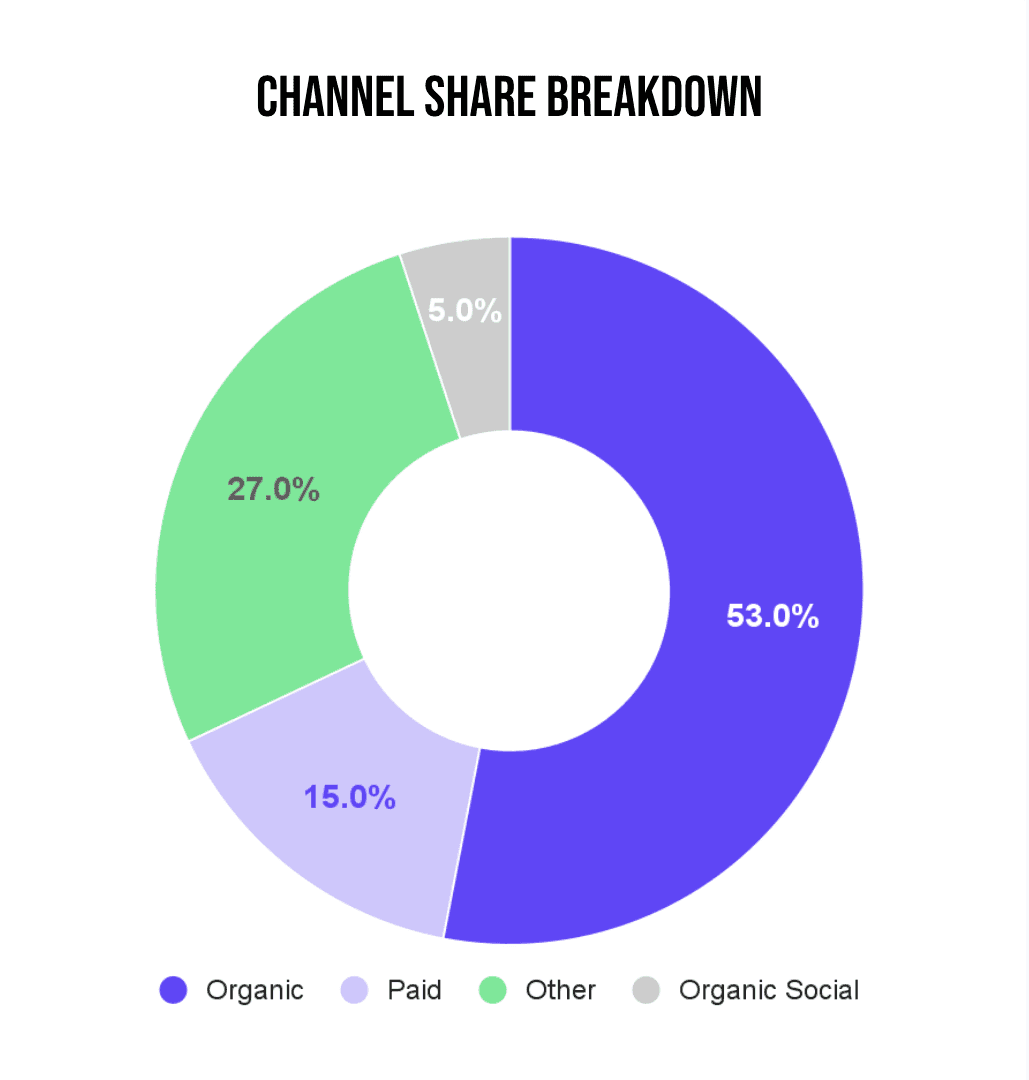Building a Business Case for SEO

WHY INVEST IN SEO?
As an SEO professional, pitching SEO work can sometimes feel like an uphill battle. Common objections include, “Organic traffic is free; why should I invest in SEO?” and “We don’t have the budget or capacity to do the work.” Addressing these concerns requires a strategic approach to demonstrate the true value of SEO.

Understanding the Value of Organic Traffic
A critical point that’s often overlooked is that organic search remains the largest source of traffic for most websites. According to a study by BrightEdge, organic traffic accounts for over half of all search traffic, while paid search only makes up around 15%. This significant proportion underscores the importance of not ignoring SEO. Investing in SEO is not about paying for traffic directly; it’s about optimising your site to harness this substantial free traffic source effectively. Ignoring SEO is akin to leaving money on the table and risking potential growth opportunities.
The Challenge of Educating Stakeholders
One of the most significant challenges in SEO is educating stakeholders, particularly senior executives or budget holders, who may not understand the intricacies of SEO. They often lack the time or willingness to learn the minute details. Therefore, it’s crucial to present a clear, concise, and compelling case that focuses on demonstrating value through data and results.
Strategies for Securing Buy-In:
-
Demonstrating Value with Data
To secure buy-in, use data to demonstrate the value of SEO . This involves using forecasting, ROI analysis, and historical data to show past successes and predict future outcomes. For example, by calculating the return on investment (ROI) of previous SEO efforts, you can clearly show how SEO has positively impacted your business. A practical approach is to remove branded traffic from your calculations to focus on non-branded traffic, which is more directly influenced by SEO efforts. Using Google Search Console data, you can filter out branded terms and calculate the increase in non-branded traffic, providing a clearer picture of SEO’s true impact.

-
Building a Strong Business Case
Creating a compelling business case involves more than just presenting data. It requires a clear narrative that explains the potential benefits of SEO in simple terms. Break down your argument into three main parts:
– ROI Forecasting:Calculate the expected ROI based on past performance and future projections.
– Opportunity Forecasting: Show the size of the potential market you could capture with improved SEO.
– Incremental Forecasting: Demonstrate the potential growth over time with consistent SEO efforts.
By presenting these forecasts, you provide stakeholders with a tangible sense of what they stand to gain from investing in SEO.
-
Addressing Challenges Proactively
Identify and address potential challenges and blockers upfront. If you can provide proactive solutions to common issues, it helps build trust and demonstrates your expertise. For example, if budget constraints are a concern, compare the costs of SEO with paid search advertising, highlighting how SEO provides ongoing value without the recurring media costs associated with PPC campaigns.
Knowing Your Audience
Tailoring your pitch to your audience is crucial. Senior executives and budget holders are more likely to be interested in the financial implications and overall business impact rather than the technical details of SEO. Focus on how SEO can drive revenue and improve the bottom line. Use numbers to simplify your argument and make it more persuasive.

Practical Tools for Forecasting
To assist with forecasting, you can use tools and templates to calculate potential traffic, conversions, and revenue. For example, by analysing monthly search volume, current click-through rates (CTR), and average order values, you can estimate the potential revenue from improved SEO rankings.
Example: Surfboards
Let’s say you’re targeting the keyword “surfboards,” which has a monthly search volume of 5,400. If your site ranks at position six with a CTR of 2.45%, you could expect 132 clicks. With a conversion rate of 1.6% and an average order value of $326, this traffic could potentially generate $691 in revenue. By scaling this approach across multiple keywords, you can build a comprehensive view of the opportunity.
Understanding SEO: From Strategy to Execution
SEO is a multifaceted discipline that demands careful planning and strategic thinking. The journey begins with a comprehensive audit and analysis, paving the way for a structured approach to implementation. In our recent webinar, we delved into the intricacies of SEO planning, execution, and the inevitable roadblocks that come with it. Here’s a recap of the key points discussed:
Timeframe for Results
When embarking on an SEO project, it’s crucial to set realistic expectations for when results will start to show. Typically, you can expect to see noticeable changes between six weeks to three months. However, this can vary; some results might appear sooner, while others may take longer. It’s essential to factor in these timelines when planning your growth strategy. Additionally, consider any significant upcoming projects that could influence these timelines. For instance, a website redesign that changes the URL structure could impact your ranking and delay results. Understanding your competition’s current standing and growth trajectory also provides context for your expected growth.
Considering External Influences
External activities, particularly from other marketing channels like PPC, can impact your SEO efforts. Since PPC and SEO often compete on the same results page for the same queries, ensure there’s no cannibalisation. Furthermore, anticipate any big marketing pushes, product launches, or service introductions throughout the year, as these can surge search volumes and influence your SEO outcomes.
Creating a Compelling Business Case
A business case is your opportunity to showcase the value of your SEO project to decision-makers. This is often your only shot to convince them, so it’s vital to include all necessary information for an informed decision. Here are some elements to consider:
– Alignment with Business Goals: Connect your project objectives to the wider business goals. If the business aims to increase revenue from a specific client type, demonstrate how your SEO efforts will contribute to this goal.
– Clear Objectives and Outcomes: Define what you want to achieve and the expected outcomes. This clarity helps decision-makers understand the potential return on investment.
– Supporting Data: Use industry case studies, company data, and external sources to back up your claims. For example, case studies like “Milliseconds Make Millions” by Deloitte can help illustrate the potential impact of improving page speed on conversions and revenue.
– Resource and Time Requirements: Be upfront about the resources needed and the level of involvement required from various team members. This transparency helps set realistic expectations.
– Identifying and Mitigating Challenges: Anticipate potential roadblocks and provide solutions in advance. This preparedness demonstrates thorough planning and can alleviate concerns from decision-makers.
Using Industry Case Studies
Industry case studies can be particularly persuasive. They offer real-world examples of how specific strategies have led to significant results. For instance, the Deloitte study on page speed improvements shows a correlation between faster load times and increased conversions and average order value (AOV). While these results may seem optimistic, they provide a benchmark for what could be achieved.
Emphasising the Cost of Inaction
Sometimes, flipping the narrative can be effective. Instead of only highlighting potential gains, underscore the risks of not taking action. Show how competitors are growing and what it might cost your business if you fall behind. Competitive analysis tools like SEMrush or Ahrefs can help illustrate this by showing share of voice and traffic comparisons.
Making Stakeholders Advocates
Your success is their success. By making stakeholders look good, you turn them into your advocates. Understand their career goals and how your project can help them achieve these. If they see the project as a way to advance their position, they’ll be more likely to support and push for its success.
Key Takeaways
– Know Your Audience: Tailor your presentation to the decision-makers. Focus on the numbers if they are data-driven or provide detailed explanations if they prefer depth.
– Let Data Do the Heavy Lifting: Use clear, concise data to support your case. Numbers often speak louder than words.
– Create Compelling Business Cases: Ensure your business case is comprehensive, addressing all necessary points to make an informed decision.
– Turn Stakeholders into Advocates: Make stakeholders look good and align your project with their career goals to gain their support.
By following these guidelines, you can effectively demonstrate the value of your SEO efforts and secure the necessary buy-in to drive your projects forward. Investing in SEO is not just about driving traffic; it’s about capitalising on the largest source of search traffic and driving sustainable business growth.

 Search
Search PR
PR AI
AI Social
Social














